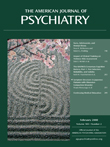Witnessing Horror at the World Trade Center
To The Editor: The study reported by Megan A. Perrin, M.P.H., et al., published in the September 2007 issue of the Journal(1) , involved a methodologic decision which may have resulted in the loss of some clinically important data and an underestimate of the traumatogenic experiences of firefighters.
The article stated that “witnessing horror,” one of the variables studied for its effects on the prevalence of probable posttraumatic stress disorder (PTSD), “was defined as witnessing any of the following: an airplane hitting the World Trade Center, a building collapsing, people running from a cloud of dust/debris, individuals being injured or killed, or people falling or jumping from the World Trade Center towers” ( 1 , p. 1387). These experiences are surely horrific, but the list includes only events at the time of the collapse.
As noted in the Cohort section, work at the World Trade Center site continued for nearly 9 months after the collapse. During that time, members of the New York City Fire Department performed the bulk of the recovery work and were repeatedly exposed to horrific scenes of decaying and dismembered human remains. In the early days of the recovery effort, firefighters often had to disassemble corpses in order to remove them from the wreckage before they burned. In later months, the remains they found were in states of increasing decomposition. All these conditions contributed to the cumulative traumatic effect of the ongoing World Trade Center experience and may help to explain the greater prevalence of PTSD found among firefighters than among other groups, such as the police.
In my capacity as staff psychiatrist for the New York City Fire Department’s Bureau of Health Services and Counseling Services Unit, I have had occasion to interview and treat hundreds of firefighters traumatized by their experiences at the World Trade Center. While large-scale bereavement and threats to personal safety were surely traumatic for them, it is the horrific experiences of the recovery period in the months after the collapse itself that regularly appear in their nightmares and flashbacks.
1. Perrin MA, DiGrande L, Wheeler K, Thorpe L, Farfel M, Brackbill R: Differences in PTSD prevalence and associated risk factors among World Trade Center disaster rescue and recovery workers. Am J Psychiatry 2007; 164:1385–1394Google Scholar



